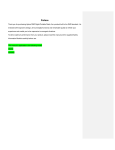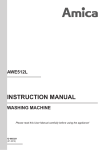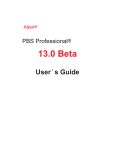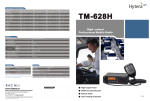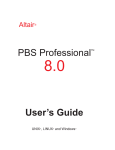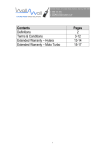Download HYTERA X1e user manual - New London Technology, Inc.
Transcript
Preface Thanks for your favor in our product. To derive optimum performance from the product, please read this manual and the supplied Safety Information Booklet carefully before use. This manual is applicable to the following model: X1e Instructional Icons Term Explanation The following icons are available through this manual: Key Operation Alert Icons Caution: indicates situations that could cause damage to your product. Note: indicates tips that can help you make better use of your product. Function Icons Short press: to press a key and release it quickly. Long press: to press a key and remain holding it down for a predefined period (2 seconds by default). Hold down: to press a key and remain holding it down. Private Call Private Call is a call initiated by a single user to another user. Group Call : indicates functions that are available on digital channel only. Group Call is a call initiated by a single user to a group. : indicates functions that are available on analog channel only. All Call is a call initiated by a single user to all the other users on a channel. Functions marked with no function icons are available on both analog and digital channels. All Call Squelch This technology can remove excessive background noises, improving your communication quality. Copyright Information Hytera is the trademark or registered trademark of Hytera Communications Co., Ltd. (the Company) in PRC and/or other countries or areas. The Company retains the ownership of its trademarks and product names. All other trademarks and/or product names that may be used in this manual are properties of their respective owners. The product described in this manual may include the Company’s computer programs stored in memory or other media. Laws in PRC and/or other countries or areas protect the exclusive rights of the Company with respect to its computer programs. The purchase of this product shall not be deemed to grant, either directly or by implication, any rights to the purchaser regarding the Company’s computer programs. Any of the Company’s computer programs may not be copied, modified, distributed, decompiled, or reverse-engineered in U.S. Patent Nos. #6,912,495 B2, #6,199,037 B1, #5,870,405, #5,826,222, #5,754,974, #5,701,390, #5,715,365, #5,649,050, #5,630,011, #5,581,656, #5,517,511, #5,491,772, #5,247,579, #5,226,084 and #5,195,166. any manner without the prior written consent of the Company. The AMBE+2 TM voice coding technology embodied in this product is protected by intellectual property rights including patent rights, copyrights and trade secrets of Digital Voice Systems, Inc. This voice coding technology is licensed solely for use within this product. The user of this technology is explicitly prohibited from attempting to decompile, reverse engineer, or disassemble the Object Code or in any other way convert the Object Code into a human readable form. details, please visit our website at: http://www.hytera.com. Disclaimer The Company endeavors to achieve the accuracy and completeness of this manual, but no warranty of accuracy or reliability is given. All the specifications and designs are subject to change without notice due to continuous technology development. No part of this manual may be copied, modified, translated, or distributed in any manner without the express written permission of us. If you have any suggestions or would like to learn more RF Radiation Information The radio is not intended for use by general population in an uncontrolled environment. It is only for occupational use and only applied to work-related conditions. The radio must be only used by users, who are fully aware of the hazards of the exposure and who are able to exercise control over their RF exposure to qualify for the higher exposure limits. RF Radiation Profile Radio Frequency (RF) is a frequency of electromagnetic radiation in the range at which radio signals are transmitted. RF technology is widely used in communication, medicine, food processing and other fields. It may generate radiation during use. RF Radiation Safety In order to ensure user health, experts from relevant industries including science, engineering, medicine and health work with international organizations to develop standards for safe exposure to RF radiation. These standards consist of: ●● United States Federal Communications Commission, Code of Federal Regulations; 47CFR part 2 sub-part J; ●● American National Standards Institute (ANSI)/Institute of Electrical and Electronic Engineers (IEEE) C95. 1-1992; ●● Institute of Electrical and Electronic Engineers (IEEE) C95. 1 – 1999; ●● International Commission on Non-Ionizing Radiation Protection (ICNIRP) 1998; FCC Regulations Federal Communication Commission (FCC) requires that all radio communication products should meet the requirements set forth in the above standards before they can be marketed in the U.S, and the manufacturer shall post a RF label on the product to inform users of operational instructions, so as to enhance their occupational health against exposure to RF energy. Operational Instructions and Training Guidelines To ensure optimal performance and compliance with the occupational/controlled environment RF energy exposure limits in the above standards and guidelines, users should transmit no more than 50% of the time and always adhere to the following procedures: Your radio radiates measurable RF energy only while it is transmitting (during talking), not when it is receiving (listening) or in standby mode. FCC Statement This equipment has been tested and found to comply with the limits for a Class B digital device, pursuant to part 15 of FCC Rules. These limits are designed to provide reasonable protection against harmful interference in a residential installation. This equipment generates and can radiate radio frequency energy and, if not installed and used in accordance with the instructions, may cause harmful interference to radio communications. However, there is no guarantee that interference will not occur in a particular installation. If this equipment does cause harmful interference to radio or television reception, which can be determined by turning the equipment off and on, the user is encouraged to try to correct. The interference by one or more of the following measures: ● Reorient or relocate the receiving antenna. Increase the separation between the equipment and receiver. ● Connect the equipment into an outlet on a circuit different from that to which the receiver is connected. ● Consult the dealer or an experienced radio/TV technician for help Operation is subject to the following two conditions: 1. This device may not cause harmful interference, and 2. This device must accept any interference received, including interference that may cause undesired operation. Note:” Changes or modifications to this unit not expressly approved by the party responsible for compliance could void the user’s authority to operate the equipment.” EU Regulatory Conformance As certified by the qualified laboratory, the product is in compliance with the essential requirements and other relevant provisions of the Directive 1999/5/EC. Please note that the above information is applicable to EU countries only. Contents Checking Items in the Package----------------------------2 Product Overview----------------------------------------------3 Product Controls---------------------------------------------------3 Programmable Keys----------------------------------------------4 Before Use------------------------------------------------------5 Charging the Battery----------------------------------------------5 Assembling Accessories-----------------------------------------6 Status Indication-----------------------------------------------8 LED Indicator-------------------------------------------------------8 Basic Operations-----------------------------------------------8 Turning the Radio On/Off----------------------------------------8 Adjusting the Volume---------------------------------------------8 Selecting a Zone---------------------------------------------------8 Selecting a Channel ----------------------------------------------8 Switching the Channel Mode-----------------------------------9 Enabling/Disabling the Bluetooth------------------------------9 Call ---------------------------------------------------------------9 Private Call -----------------------------------------------------9 Group Call ------------------------------------------------------9 All Call -----------------------------------------------------------10 Calls on Analog Channels ----------------------------------10 Functions and Operations-----------------------------------11 Adjust Power Level------------------------------------------------11 1 Scan ------------------------------------------------------------------11 Talk Around ---------------------------------------------------------11 Monitor ----------------------------------------------------------12 Squelch Off ----------------------------------------------------12 Adjust Squelch Level ----------------------------------------12 One Touch Call-----------------------------------------------------13 Telemetry -------------------------------------------------------13 Roam ------------------------------------------------------------14 Emergency----------------------------------------------------------14 Man Down-----------------------------------------------------------17 Scrambler /Encrypt -------------------------------------18 Lone Worker--------------------------------------------------------18 Battery Strength Indicator---------------------------------------19 Busy Channel Lockout-------------------------------------------19 Time-out Timer (TOT) --------------------------------------------19 Pseudo Trunking ---------------------------------------------20 MIC AGC-------------------------------------------------------------20 Radio Registration Service --------------------------------20 GPS Revert ----------------------------------------------------20 Troubleshooting------------------------------------------------21 Care and Cleaning--------------------------------------------23 Checking Items in the Package Please unpack carefully and check that all items listed below are received. If any item is missing or damaged, please contact your dealer. Radio Unit Power Adapter Battery Strap Charger Antenna Manuals Quick Referen ce Gui de Note: The antenna may vary with different frequency bands. And the frequency band is marked on the label of antenna; if not, please refer to the label on the terminal for frequency band information. 2 Product Overview Product Controls No. 1 2 3 4 5 6 7 8 9 10 11 3 Part Name Accessory Jack Radio On-Off/Volume Control Knob LED Indicator Channel Selector Knob SK (Side Key) PTT Key Speaker Antenna TK (Top Key) Microphone Battery Product Overview Programmable Keys 11 Emergency For enhanced convenience, you may request your dealer to program the keys SK and TK as shortcuts to the functions listed below: No. Shortcut Key 1 Zone Up 2 Zone Down Function To select a desired zone quickly 12 13 Adjust Squelch Level Battery Strength Indicator 14 Man Down 3 Adjust Power Level To adjust power level quickly 4 Talk Around To directly communicate with other radios 15 To a d j u s t t h e c o n d i t i o n f o r incoming signal match 16 Lone Worker 5 Monitor 6 Monitor Momentary 7 Squelch Off To always unmute speaker no Squelch Off Momentary matter whether carrier is present 8 or not 9 Scan 10 Nuisance Temporary Delete To r e c e i v e s i g n a l s o n o t h e r channels To temporarily ignore unwanted channel activity Scrambler To summon help in emergent situations To temporarily adjust the squelch threshold required for the radio to unmute To indicate the battery strength To activate Emergency in the case that the radio is positioned aslant for a preset time period due to an unexpected situation To encrypt your voice so as /Encrypt to guarantee privacy of your communication To protect the operators from accidents 17 One Touch Call 1-5 To make corresponding services 18 Telemetry To supervise remote devices 19 Roam To communicate between sites in the IP Multi-site Connect system. 4 Product Overview Note: (1) Long and short press of a key can be assigned with different functions by your dealer. (2) T h e T K i s p r o g r a m m e d a s t h e Emergency key by default, and is programmable by your dealer. Before Use Charging the Battery Power off the radio before charging it. Use only the charger and battery specified by Hytera. Charger LED can indicate the charging process. Charging Diagram Procedures 1. Connect the power adapter to AC socket. See arrow ① . 2. Plug the power adapter into the rear jack of the charger. See arrow ② . Place the radio with the battery attached, or the battery alone, into the charger. 3. 5 Before Use 4. The charging process initiates when LED glows red, and is completed when LED glows green. Note: To achieve optimal battery performance, please charge the battery for 3 hours before initial use. LED Indicator LED Indicator Charger Status Red LED flashes slowly. Standby (no load) Red LED glows. Charging Orange LED glows. 90% charged Green LED glows. Fully charged Red LED flashes rapidly. Failure To remove the antenna, rotate it counter-clockwise. Assembling the Battery 1. 2. Insert the battery into top of the radio. See arrow ① . Slightly press the bottom of the battery until a click is heard. See arrow ② . 2 1 Caution: B e s u r e t o r e a d t h e S a f e t y Information Booklet, to get necessary safety information. Assembling Accessories Assembling the Antenna To remove the battery, turn off the radio first. Then push the lock to loosen the battery latch (as indicated by ① ) , and slide Turn the antenna clockwise to fasten it. the battery latch upwards to unlock the battery. 6 Before Use 2 1 Assembling the Audio Accessory 1. 2. 3. Open the accessory jack cover as the arrow shown. Align the plug with the accessory jack. Tighten the screw on the plug. To remove accessories, loosen the screw. Caution: Please attach the accessory properly; otherwise, waterproof performance of the radio may get affected. 7 Status Indication Basic Operations LED Indicator Turning the Radio On/Off The top LED indicator will help you easily identify the current radio status. Rotate the Radio On-Off/Volume Control knob clockwise/ counter-clockwise until a click is heard to turn the radio on/off. LED Indication Radio Status LED flashes green. Powering on LED glows red. Transmitting LED glows green. Receiving LED flashes orange slowly. Scanning LED flashes orange rapidly. Emergency LED glows orange. After voice communication ends, you can hold down the PTT key to talk while the LED is glowing orange. LED flashes red and blue. Paring the Bluetooth LED flashes blue. Paired successfully Adjusting the Volume After turning the radio on, rotate the Radio On-Off/Volume Control knob clockwise to increase the call volume, or counterclockwise to decrease it. Selecting a Zone A zone is a group of channels exhibiting the same property, and is programmed by your dealer. The radio supports 3 zones: Zone 1, Zone 2 and Zone 3. Each zone contains 16 channels at most. You may quickly toggle to your desired zone by pressing the programmed Zone Up or Zone Down key. In the process, you will hear one alert tone for Zone 1, two alert tones for Zone 2 and three alert tones for Zone 3. Selecting a Channel After turning the radio on, rotate the Channel Selector knob to select a desired channel. 8 Basic Operations Switching the Channel Mode Each channel can be programmed as either analog channel or digital channel. If the current zone includes both analog and digital channels, you may quickly switch between digital and analog through the Channel Selector knob. Enabling/Disabling the Bluetooth Short press the SK key twice to enable/disable the Bluetooth. If it is enabled, the LED will flash blue. To use the Bluetooth function properly, please arrange the radio by any of the following way: ●● Wear the radio and the Bluetooth earpiece on the same side of your body, with the radio’s front side facing your body. The distance between the radio and Bluetooth earpiece must not exceed 0.5m. ●● lPlace the radio at a place no more than 2m away from the Bluetooth earpiece, with the radio’s rear side facing the Bluetooth earpiece. Caution: Please use our POA43 Bluetooth earpiece. 9 Call Note: Your dealer may preset a contact for each digital channel. The preset contact could be a Private Call contact, a Group Call contact or an All Call contact. To e n s u re o p t i m a l v o l u m e of t h e receiving radio, hold the palm microphone approximately 2.5 to 5 centimeters away from your mouth. Private Call Transmitting a Private Call In the standby mode, hold down the PTT key to transmit a Private Call to the Private Call contact preset for the current channel. Receiving and Responding to a Private Call When a Private Call is received, you can listen to it without any operation, and you may hold down the PTT key within the preset time period to call back. Call Group Call Transmitting a Group Call In standby mode, hold down the PTT key to transmit a Group Call to the Group Call contact preset for the current channel. Receiving and Responding to a Group Call Note: You cannot respond to an All Call. Calls on Analog Channels To transmit on an analog channel, hold down the PTT key and speak into the microphone. To receive, release the PTT key. When a Group Call is received, you can listen to it without any operation, and you may hold down the PTT key within the preset time period to call back. All Call Transmitting an All Call In standby mode, hold down the PTT key to transmit an All Call to the All Call contact preset for the current channel. Note: You can transmit an All Call only when it is enabled by your dealer. Receiving an All Call When an All Call is received, you can listen to it without any operation. 10 Functions and Operations Adjust Power Level With this feature, you may switch power levels quickly. Generally, we recommend you to adopt low power for battery saving. However, if you cannot communicate with radios located at a distant place with low power, please select high power. Operation: Press the programmed Adjust Power Level key to switch between high power and low power (from low power to high power: a high-pitched tone sounds; from high power to low power: a low-pitched tone sounds). 2. ●● ●● ●● ●● Scan The Scan feature allows you to listen to communication activities on other channels so that you can keep a close track of your team members. Operation: 1. To enable the feature, press the programmed Scan key in standby mode (a high-pitched tone sounds); or Switch to a channel for which the feature “Auto Scan” is enabled via the programming software. 11 After the feature is enabled, your radio will scan according to the scan list set for the channel on which scanning starts. The scanning process is as follows: During scanning, the LED flashes orange. When activities are detected on a channel, the radio will stay on the channel to receive current activities, and the LED glows green. If you don’t want to hear activities on the channel, press the programmed Nuisance Temporary Delete key to remove the channel from the scan list temporarily. If you want to continue staying on the channel, press the programmed Monitor or Squelch Off key during scan stay. 3. To exit the scanning process, press the programmed Scan key again (a low-pitched tone sounds). Talk Around This feature allows you to continue communication even when the repeater malfunctions, or when your radio is out of the repeater’s range but within the coverage range of other radios. Operation: Functions and Operations Press the programmed Talk Around key to enable the feature (a high-pitched tone sounds). To disable the feature, press this key again (a low-pitched tone sounds). Monitor To adjust match conditions for signal receiving, you can enable the feature “Monitor”. Operation: ●● Press the programmed Monitor key to enable the feature (a high-pitched tone sounds). To disable the feature, press this key again (a low-pitched tone sounds). ●● Hold down the programmed Monitor Momentary key to enable the feature (a high-pitched tone sounds). To disable the feature, release this key (a low-pitched tone sounds). Squelch Off If the feature “Squelch Off” is enabled, your radio’s speaker will keep unmuted no matter whether carrier is present. Operation: ●● Press the programmed Squelch Off key to enable the feature, and the radio sounds background noise (a high- ●● pitched tone sounds). To disable the feature, press this key again (a low-pitched tone sounds). Hold down the programmed Squelch Off Momentary key to enable the feature, and the radio sounds background noise (a high-pitched tone sounds). To disable the feature, release this key (a low-pitched tone sounds). Adjust Squelch Level This feature allows you to adjust the squelch threshold required for the radio to unmute. Generally, “Tight” is used in high noise environment. It requires stronger signal for the radio to unmute. If the squelch level is set to Open, the speaker will keep unmuted irrespective of the satisfaction of decoding conditions. Operation: Press the programmed Adjust Squelch Level key to switch among Tight, Open and Normal (from Tight to Open, a lowpitched tone and background sound are heard; from Open to Normal, a high-pitched tone is heard and the background sound disappears; from Normal to Tight, a high-pitched tone is heard). 12 Functions and Operations One Touch Call You can request your dealer to set the One Touch Call key. By pressing such programmed key, you can make corresponding services detailed as below: ●● Services on the analog channel: to make a call to the 5-Tone or 2-Tone contact. ●● Services on the digital channel: To send message to the Group Call contact. To send message or make control services to the Private Call contact. The control services contain: Alert Call, Radio Check, Remote Monitor, Radio Enable or Radio Disable. Alert Call You can send an alert call to a Private Call contact. The called party will see the alert and can call you back. Radio Check You can send a Radio Check command to a Private Call contact, so as to confirm whether it is powered on or running on the current channel without disturbing it. Remote Monitor You can enable the microphone of a Private Call contact, and monitor its activities or background voices remotely. 13 Radio Enable You can enable the radio of a Private Call contact remotely and allow it to be used normally. Radio Disable You can disable the radio of a Private Call contact remotely and disallow it to be used normally. Telemetry This feature allows you to remotely supervise the device connected with a radio. With this feature, you can control the device and view its status in the case that you are away from the device. The method for supervising the device is programmable by your dealer. The available methods are: ●● To supervise the device via the radio If a device is connected with a radio, you can use another radio to supervise the device. All the radios involved should be configured with the Telemetry feature. For example, the dealer enables the Telemetry feature for both Radio A and Radio B, and assign the Telemetry feature to the SK key on Radio A. To supervise the device C, connect it with Radio B, and press the SK key on Radio A. Functions and Operations ●● To supervise the device via a third-party software If the Telemetry feature is enabled for the radio by your dealer, you can supervise the device connected with the radio via a third-party software. Roam This feature allows the radio to communicate between sites in the IP Multi-site Connect system. If enabled, the radio can communicate via any site in the IP Multi-site Connect system, thus ensuring seamless communication in the system. Operation: Go to “Menu -> Settings -> Radio Set-> Roam”, and select “Enable” or “Disable”. Press the programmed Roam key to enable or disable the feature. Emergency In case of an emergency, you can use the feature to ask for help from your companion or control center. The Emergency process has the highest priority. You can make emergency operation even when your radio is transmitting or receiving. To enable the feature on a channel, an emergency system must be assigned to the channel via the programming software. In addition, the Emergency type, Emergency ID type and Emergency mode are settable via the programming software. Emergency Type For each Emergency mode, there are four Emergency types available. You can select one of them via your deale Emergency Type Siren Only Regular Silent Silent with Voice Description In Emergency mode, the radio will sound shrill alarm tone. In Emergency mode, the radio will give audible and visible indication. In Emergency mode, the radio won't give any audible or visible indication. In Emergency mode, the radio won’t give any audible or visible indication, but will receive voice ACK from the companion or control center automatically. Emergency ID Type Your radio supports two Emergency ID types. You can select one of them via your dealer: 14 Functions and Operations Emergency ID Type None HDC1200 Description No signaling is used when the radio sends alarm information. HDC1200 signaling is used when the radio sends alarm information. Emergency Mode Your radio supports three Emergency modes. You can select one of them via your dealer (Note: For the following operation methods, we take the “Regular” type as an example). Emergency Mode Alarm Alarm with Call 15 Description In this mode, you can send alarm information to your companion or control center by pressing the programmed Emergency key, but you cannot talk with them. In this mode, you can send alarm information by pressing the programmed Emergency key. When the alarm tone disappears (None) or after the Emergency ID is sent (HDC1200), you can speak into the microphone, allowing your voice and background noise to be transmitted automatically (you do not need to hold down the PTT key). Call Only In this mode, press the programmed Emergency key to go to the Revert Channel, and speak into the microphone, allowing your voice and background noise to be transmitted automatically (you do not need to hold down the PTT key). Operation Methods for Analog Emergency Alarm (None & HDC1200) Operation: Press the programmed Emergency key to send alarm information, and the LED glows red. (None: If “Local Emergency Alarm” is enabled via the programming software, an alarm tone will sound.) The following methods are available for you to exit the Emergency mode: 1. Once the Alarm Cycles expire, the radio will exit the Emergency mode automatically. 2. Long press the programmed Emergency key. 3. Hold down the PTT key. The radio will transmit on the channel on which the radio operates before entering the Emergency mode. (HDC1200) Functions and Operations Alarm with Call (None & HDC1200) Operation: 1. Press the programmed Emergency key to send alarm information, and the LED glows red. (None: If “Local Emergency Alarm” is enabled via the programming software, an alarm tone will sound.) 2. When the alarm tone disappears (None) or after the Emergency ID is sent (HDC1200), you can speak into the microphone to make an emergency call. 3. When the LED flashes orange, your radio is receiving. Two methods are available for you to exit the Emergency mode: 1. After the preset Alarm Cycles and Voice Cycles expire, the radio will exit the Emergency mode automatically. (None) 2. Long press the programmed Emergency key. Call Only (HDC1200) Operation: 1. Press the programmed Emergency key to go to the 2. Revert Channel, and the LED glows red. If the feature “Alarm with Call to Follow” is enabled, you can speak into the microphone to make an emergency call 3. When the LED flashes orange, your radio is receiving. To exit the Emergency mode, long press the programmed Emergency key. Note: Your dealer may set the number of alarm cycles and alarm duration (None), number of polite retries and impolite retries (HDC1200), number of voice cycles, duration of each transmission and TX interval. Operation Method for Digital Emergency Alarm Operation: Press the programmed Emergency key to send alarm information. At this time, the LED glows red. Two methods are available for you to exit the Emergency mode: 1. Once the Alarm Cycles expire, the radio will exit the Emergency mode automatically. 2. Long press the programmed Emergency key. when the LED glows red. 16 Functions and Operations Alarm with Call Operation: 1. Press the programmed Emergency key to send alarm information. At this time, the LED glows red. 2. When the LED solidly glows red, you can speak into the microphone to make an emergency call. 3. When the LED flashes orange quickly, you can receive. And when a call is received, the LED glows green solidly. 4. If the preset Voice Cycles expire, you can press the PTT key to make the emergency call again (the LED glows red). Release the PTT key to receive (the LED flashes orange quickly); when a call is received, the LED glows green solidly. To exit the Emergency mode, long press the programmed Emergency key. Call Only Operation: 1. Press the programmed Emergency key to go to the 2. Revert Channel. If the feature “Alarm with Call to Follow” is enabled, you can speak into the microphone to make an emergency call when the LED glows red. 17 3. When the LED flashes orange, your radio is receiving. If the preset Voice Cycles expire, you can hold down the PTT key to make the emergency call again (the LED glows red). After the emergency call is transmitted, please release the PTT key to receive. To exit the Emergency mode, long press the programmed Emergency key. Note: Your dealer may set the number of polite retries and impolite retries, number of voice cycles, duration of each transmission and TX interval. Man Down With this feature, your radio will alarm automatically to summon help from your companion if it is positioned aslant for a certain time period. Operation: 1. To enable the feature, ●● Press the programmed Man Down key (a high-pitched tone sounds); or Functions and Operations ●● 2. 3. ●● Turn on the radio if the feature is enabled via the programming software. Your radio will sound a pre-alert tone if it is positioned aslant for a preset time period, and will enter the Emergency mode if you do not place it vertically within such time period. To exit the Emergency mode, please place it upright. To disable the feature, Press the programmed Man Down key (a low-pitched tone sounds). Scrambler /Encrypt The Scrambler/Encrypt feature can encrypt your audio signals to prevent eavesdropping. Thus privacy of your communication is guaranteed. Operation: ●● Press the programmed Scrambler/Encrypt key to enable Scrambler or Encrypt on the current channel (a highpitched tone sounds); press the key again to disable the feature (a low-pitched tone sounds). ●● If the Scrambler/Encrypt feature is enabled for a channel via the programming software, switch to the channel to enable the feature, or exit the channel to disable the feature. Lone Worker This feature is ideal for persons who work lonely. If you encounter an incident and cannot operate your radio within the preset time period, your radio will alarm automatically to summon help from your companion. Operation: 1. To enable the feature, Press the programmed Lone Worker key (a high-pitched tone sounds); or 2. 3. Turn on the radio if the feature is enabled via the programming software. If you cannot operate your radio within a preset response period, your radio will give alerts before this period expires (dependent on the settings by your dealer). At this time, you can terminate such alerts by rotating a knob or pressing a key. When the response period expires, your radio will trigger the current emergency system automatically. To disable the feature, 18 Functions and Operations Press the programmed Lone Worker key (a low-pitched tone sounds). Note: If the Lone Worker feature is not disabled before your radio is powered off, it will remain enabled when powered on again. Battery Strength Indicator This feature allows you to know the current battery strength. Operation: Hold down the programmed Battery Strength Indicator key, and the radio will give a specific indication to represent the current battery strength. Release the key to exit. Indication Battery Strength Green LED glows. High Orange LED glows. Medium Red LED glows. Low Red LED g l o w s a n d th e l o w Insufficient battery alert sounds. 19 Busy Channel Lockout If enabled via the programming software, this feature can prevent your radio interfering with other transmitting terminals on the same channel. If you hold down the PTT key while the channel is in use, your radio will keep beeping, alerting you to transmission prohibition. To stop beeping, please release the PTT key. When the channel is free, you can press and hold down the PTT key to transmit. Time-out Timer (TOT) The purpose of TOT is to prevent any user from occupying a channel for an extended period. If the preset time expires, the product will automatically terminate transmission and keep beeping. To stop beeping, please release the PTT key. You must wait for a certain time period (preset by your dealer) to initiate another transmission. If the pre-alert function is set by your dealer, your radio will alert you to the TOT expiration in advance. Note: This feature is null in Emergency mode. Functions and Operations Pseudo Trunking If enabled via the programming software, If your radio operates on a channel with this feature enabled and one time slot is already occupied, it can transmit and receive on the other free time slot, allowing you to communicate timely under emergent situations. will transfer its positioning information to the system when the system requires such information. MIC AGC If enabled via the programming software, your product will process the audio signals during transmission, providing improved audio for the receiving product. Radio Registration Service If enabled via the programming software, your radio will automatically register in the system within a certain period after power-on. Then it can acquire online information of other radios via accessing specific servers within the valid registration period. GPS Revert If enabled via the programming software, your registered radio 20 Troubleshooting Phenomena Analysis Solution The battery may be improperly installed. Remove the battery and attach it again. The product can not be powered on. The battery may run out. The battery may suffer from poor contact caused by dirtied or damaged battery contacts. The battery strength may be too low. Recharge or replace the battery. Clean the battery contacts. If the problem can not be solved, contact your dealer or authorized service center for inspection and repair. Recharge or replace the battery. During receiving signals, the voice is weak, discontinuous or totally inactive. The volume may be set to a low level. The antenna may get loose or may be improperly installed. Increase the volume. You can not communicate with other members. 21 Power off the product, and re-install the antenna. The speaker may be blocked or damaged. Clean surface of the speaker. If the problem can not be solved, contact your dealer or authorized service center for inspection and repair. The frequency or signaling may be inconsistent with that of other members. Set your TX/RX frequency and signaling to the same as that of other members. The channel type (digital/analog) may be set inconsistently. Make sure all members are on the same digital/analog channel. You may be too far away from the group members. Move towards other members. Troubleshooting Irrelevant communication or noise is heard on the channel. The noise is too loud. The GPS cannot locate your position. The Bluetooth cannot be paired. You may be interrupted by products using the same frequency. Change the frequency, or adjust the squelch level. The product may be set with no signaling. Set signaling for all member products to avoid interference at the same frequency. You may be too far away from other members. You may be at an unfavorable position. For example, your communication may be blocked by high buildings or frustrated in the underground areas. You may suffer from external disturbance (such as electromagnetic interference). Move towards other members. Move to an open and flat area, and restart the product. Stay away from equipment that may cause interference. No GPS signal is received. Move to an open and flat area, and restart the product. The battery power for the Bluetooth may run low. Charge the Bluetooth. The Bluetooth may be too far away from the product. Move the Bluetooth towards the product. If the above solutions can not fix your problems, or you may have some other queries, please contact us or your local dealer for more technical support. 22 Care and Cleaning To guarantee optimal performance as well as a long service life of the product, please follow the tips below. Product Care ●● ●● ●● ●● Do not pierce or scrape the product with any edged instruments or hard objects. Keep the product far away from substances that can corrode the circuit. Do not hold the product by its antenna or earpiece cable directly. Attach the accessory jack cover when the product is not in use. Product Cleaning ●● ●● Clean up the dust and fine particles on the product surface and charging piece with a clean and dry lint-free cloth or a brush regularly. Use neutral cleanser and a non-woven fabric to clean the keys, control knobs and front case after long-time use. Do not use chemical preparations such as stain removers, alcohol, sprays or oil preparations, so as to avoid surface case damage. Make sure the product is completely dry before use. 23 Caution: Power off and remove the battery before cleaning.






























